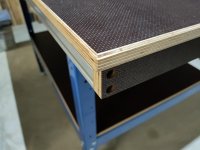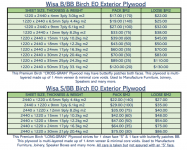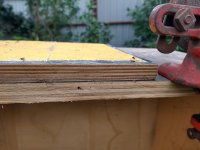Hi all,
I was wondering if a hollow cube or rectangular prism (like speaker enclosure) made of MDF or HDF walls of sufficiently high thickness, would at a certain minimum thickness show no measurable benefit from internal bracing regardless of frequency range and typical SPL requirements?
Thickness would be proportional to box size.
Assume there is a sub woofer in the enclosure.
Greets!
Absolutely!
Understand though that stiffness goes up at the cube of thickness, so with confirmed Ga. Pacific MOE specs ~ two decades ago now:
~ 3/4" marine, BB, etc., ply = ~1.8 mil psi
~3/4" MDF = ~527 k psi
[0.75*[1.8/.527]^0.33] = 1.125" thick
With increasing box size then, you're ~ quickly moving into cast iron construction heavy to raise a sub's box resonance up the/[my] desired one octave minimum.
In short, start with the lightest, highest MOE material you can afford; that or go the opposite as some have done [me included to save $$, effort] and epoxy/whatever concrete, granite or similar pieces together and use [some of] the savings on a good appliance hand truck 😉.
All i know is that many Ozzies say plywood is hard to find.
Maybe regional? Or 30 years ago?
I do know that there is a 17mm hoop pine plywood with many plies that seems to be good.
It is also ~$250 a sheet, like birch.
Basic (random species) ply, of the same structural grade, is < $100, and available at any of the hardware chains.
The reason Australians would be saying that plywood is hard to find is because audio forums are echo chambers that have drummed up that birch ply is some sort of godlike speaker box building material that nothing else can surpass.
Birch ply is not commonly found in Australian hardware stores as it is an imported product and hardware stores usually stock mostly local wood. The ply that is easy to find is structural so it generally looks like ***.
I just make enclosures out of MDF. Most bang for buck and with some thought put into bracing they don't need to have thick walls or weigh 100kg. Easier to paint than ply.
Birch ply is not commonly found in Australian hardware stores as it is an imported product and hardware stores usually stock mostly local wood. The ply that is easy to find is structural so it generally looks like ***.
I just make enclosures out of MDF. Most bang for buck and with some thought put into bracing they don't need to have thick walls or weigh 100kg. Easier to paint than ply.
Last edited:
If you do constrained layer construction, it matters less. Birch is known as a tonewood, suggested for instruments, or for when you want to add to a speaker or will not be choosing to damp.
... echo chambers that have drummed up that birch ply is some sort of godlike speaker box building material that nothing else can surpass.
The actual material the plywood is made from is much less important than the construction detail and execution. BB is often quoted as it is an example of a (usually) quality plywood widely available.
Stiff & light is preferred. No voids. Lots of plies.
dave
It is also ~$250 a sheet, like birch.
At prices like that i would be looking at bamboo. We paid les sthan $100/sheet for the quality plywood we used at the end (Murphy ply), which was about double the cheap Russian BB we abandoned after quality went downhill.
Still, after all the drivers and all the laboutr likely still worth the price over MDF/HDF (which we could have pretty much as much as we would need for $0)
dave
Right, Down Under, I imagine no void marine grade ply like I've used would be in abundance, hence maybe comparatively inexpensive.
Most bang for buck and with some thought put into bracing they don't need to have thick walls or weigh 100kg. Easier to paint than ply.
Indeed! Construct like an air frame and can 'skin' it with thin sheets, though ideally need to mass load it with something [removable] if designed for < 100 Hz high power apps.
Nothing in Australia is inexpensive especially locally produced items 😡
The price and quality available depends heavily on where you are located. I was regional for a long time and everything had to be shipped usually at a similar cost to value of the item.
Now I live within driving distance of DMK Forrest products and I can buy Finnish Birch at quite reasonable prices. The price of a sheet of 18mm is about $150 AUD which is a little more than 100USD at the current exchange rate.
The Hoop Pine ply is similar or more expensive if a higher finish grade is desired. Having bought both the birch is better.
Imported Marine ply from the big hardware stores was about the same price when I bought a sheet, it's OK but not as nice as the Birch if it is available.
The price and quality available depends heavily on where you are located. I was regional for a long time and everything had to be shipped usually at a similar cost to value of the item.
Now I live within driving distance of DMK Forrest products and I can buy Finnish Birch at quite reasonable prices. The price of a sheet of 18mm is about $150 AUD which is a little more than 100USD at the current exchange rate.
The Hoop Pine ply is similar or more expensive if a higher finish grade is desired. Having bought both the birch is better.
Imported Marine ply from the big hardware stores was about the same price when I bought a sheet, it's OK but not as nice as the Birch if it is available.
Attachments
Bummer! 🙁 I assumed the economic 'landscape' had changed considerably since the early '70s when the then Cutler-Hammer Corp. was considering moving me to a plant down in Sydney, but then wife nixed it.
Oh well, there's always fiberglass and paper mache. 😉
Oh well, there's always fiberglass and paper mache. 😉
Right, Down Under, I imagine no void marine grade ply like I've used would be in abundance, hence maybe comparatively inexpensive.
Yep - not sold as "marine" but functionally similar.
Top bit (sanding block) is a scrap of cheap, locally made construction ply - formply for concrete work.
The bottom ply is the remnants of a JBL cab that I butchered for parts.
The plywood in the JBL box is perfectly adequate, but clearly has fewer layers and more flaws.
The cheap formwork stuff has the same structural properties (stiffness:weight etc) as $$ imported birch. It is also waterproof enough that timber yards simply store it outside, exposed to the weather.
I use formply outside. It ignores rain. It takes a couple before the (unsealed) edges begin to show any weathering. If I waxed the cut edges, they'd probably last ~forever.
Attachments
Like everything there are variations available that may or may not be the same. Bunnings is selling a 17mm F14 grade Formply made out of Radiata Pine for $88. Your sample looks more like hardwood and very similar to the imported Marine Ply Bunnings sells. There is quite a difference between that and a good quality Birch ply. Whether it is worth the extra will depend on the application. One thing to look out for is that hardwood ply with a high number of plies will tend to stay straighter for longer without weight on it. The Pine plywood starts to banana very quickly even the expensive Hoop Pine stuff.
" Bunnings is selling a 17mm F14 grade Formply"
They used to sell F17, but appear to be out of stock. You can still get it from multiple places - Plyco, Big River, Allcon, Bowen's...
Some of them sell it without the black phenolic face (e.g. for flooring).
"There is quite a difference between that and a good quality Birch ply"
If two sheets are both labelled as "F17", then they have been measured by Official Clever People and found to have similar engineering properties - including stiffness, which is the heading of this thread.
Structural grading | WoodSolutions
They used to sell F17, but appear to be out of stock. You can still get it from multiple places - Plyco, Big River, Allcon, Bowen's...
Some of them sell it without the black phenolic face (e.g. for flooring).
"There is quite a difference between that and a good quality Birch ply"
If two sheets are both labelled as "F17", then they have been measured by Official Clever People and found to have similar engineering properties - including stiffness, which is the heading of this thread.
Structural grading | WoodSolutions
Very true none of this has much to do with the thread title. My point was that products can be rated the same for structural strength and yet be quite different. Softwood being different to hardwood in how it cuts, bends and holds fasteners which might be quite relevant to how well it holds up in the long term as a cabinet choice.If two sheets are both labelled as "F17", then they have been measured by Official Clever People and found to have similar engineering properties - including stiffness, which is the heading of this thread.
The picture of the formply in post 31 looks very nice. I would have no qualms about using that as a cabinet material. Any plywood that has a lot of ply layers and is internally void free is very suitable. I use baltic birch because in my region it is easy to get and not expensive. In December I bought 3 sheets. The price for a 60" x 60" (1524mm x 1524mm) 18mm/13 ply sheet was $55 US.
j.
j.
This seems to be a difficult question as no one has really taken a stab at putting numbers on it. Although I have not made any real tests of this, in my experience layers of very high quality plywood in the range of 40-50mm thick results in minimal box or baffle talk. That would be in boxes of 300-600 liters. Minimal, but sturdy, bracing used. 30-40mm of MDF seem to be the minimum for deadness on an open baffle were there is no box pressure....MDF or HDF walls of sufficiently high thickness, would at a certain minimum thickness show no measurable benefit from internal bracing<snip>?
Those are just observations from builds I have done or listened to. No real data, just empirical observation.
In a subwoofer it is fairly easy to push the potemtial resonances well above the pass band where they will not be excited. More of an issue is ballooning of the box.
dave
Can you elaborate please in what way is ballooning an issue?
If the box balloons the box volume chsngrd (subtly) but more importantly the whole box becomes an active radiator.
dave
dave
One thing to look out for is that hardwood ply with a high number of plies will tend to stay straighter for longer without weight on it.
Right, the marine grade I've used were all 13 ply, while the recommended BB ply that is sold locally is 'only' 11 ply, though is cheaper and IIRC Tom D. said his subs were 13 ply.
The BB we used was 13 plies for 15mm, 15 for 18mm. The Murphy ply had 2 more plies for the same (nominal) thickness.
dave
dave
- Home
- Loudspeakers
- Multi-Way
- Question for engineers about enclosure stiffness



